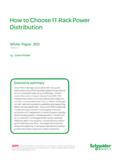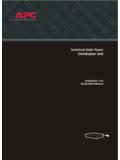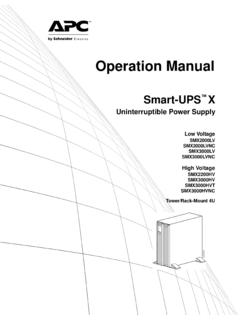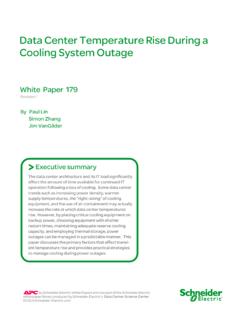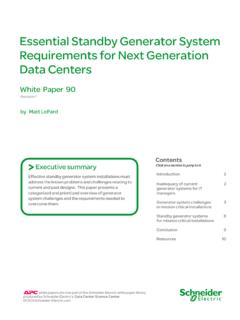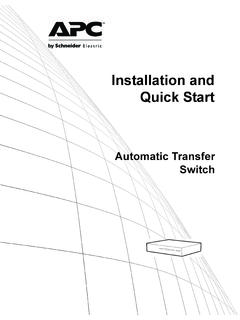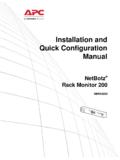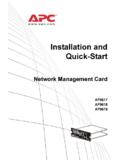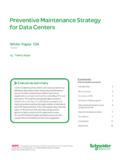Transcription of The Different Technologies for - - APC USA
1 The Different Technologies for Cooling Data Centers Revision 2 by Tony Evans Introduction 2 Heat removal methods3 Cooling system options14 Conclusion 15 Resources 16 Click on a section to jump to it Contents White Paper 59 There are 13 basic heat removal methods to cool IT equipment and to transport unwanted heat to the outdoor environment. This paper describes these fundamental cooling Technologies using basic terms and diagrams. 11 of these methods rely on the refrige-ration cycle as the primary means of cooling. Pumped refrigerant systems provide isolation between the primary heat removal system and IT equipment.
2 The direct air and indirect air methods rely on the outdoor conditions as the primary means cooling making them more efficient for mild climates. The information in this paper allows IT professionals to be more involved in the specification of precision cooling solutions that better align with IT objectives. by Schneider Electric White Papers are now part of the Schneider Electric white paper library produced by Schneider Electric s Data Center Science Center Executive summary> The Different Technologies for Cooling Data Centers Schneider Electric Data Center Science Center White Paper 59 Rev 2 2 Data center heat removal is one of the most essential yet least understood of all critical IT environment processes. As the latest computing equipment becomes smaller and uses the same or even more electricity than the equipment it replaced, more heat is being generated in data centers.
3 Precision cooling and heat rejection equipment is used to collect and transport this unwanted heat energy to the outside atmosphere. This paper explains the 13 cooling Technologies and their components designed to transport heat energy from the IT environment to the outside atmosphere. The information presented here is a foundation allowing IT professionals to successfully manage the specification, installation, and operation of IT environment cooling systems. For definitions of various terms used throughout this paper, see White Paper 11, Explanation of Cooling and Air Conditioning Terminology for IT Professionals. How air conditioners work White Paper 57, Fundamental Principles of Air Conditioners for Information Technology provides information regarding the nature of heat in the IT environment, operation of the refrigeration cycle, and the basic functionality of precision cooling devices and outdoor heat rejection equipment.
4 Cooling architectures A cooling architecture is fundamentally described by: 1. A particular heat removal method (the subject of this paper) 2. A particular air distribution type 3. The location of the cooling unit that directly supplies cool air to the IT equipment These three elements are briefly described below, along with their white paper references, in order to provide context around the entire data center cooling system. Heat removal Heat removal is the subject of this paper. Air distribution This is a very important part of the cooling system as air distribution to IT equipment greatly affects its overall performance. White Paper 55, The Different Types of Air Distribution for IT Environments describes the nine basic ways air is distributed to cool IT equipment in data centers and network rooms. Location of the cooling unit The cooling unit is defined in this paper as the device that provides cool supply air to the IT equipment.
5 There are four basic cooling unit locations. In general, the cooling unit is separate from the other heat rejection system devices. In some cases, the entire cooling architecture is containerized and located outdoors adjacent to the data center. The location of the cooling unit plays a significant role in data center design including overall cooling efficiency, IT power density (kW / rack), and IT rack space utilization. For more information see White paper 130, The Advantages of Row and Rack-Oriented Cooling Architectures for Data Centers. Introduction Fundamental Principles of Air Conditioners for Information Technology Link to resource White Paper 57 Explanation of Cooling and Air Conditioning Terminology for IT Professionals Link to resource White Paper 11 The Advantages of Row and Rack-Oriented Cooling Architectures for Data Centers Link to resource White Paper 130 The Different Types of Air Distribution for IT Environments Link to resource White Paper 55 The Different Technologies for Cooling Data Centers Schneider Electric Data Center Science Center White Paper 59 Rev 2 3 There are 13 fundamental heat removal methods to cool the IT environment and transport unwanted heat energy from IT equipment to the outdoors.
6 One or more of these methods are used to cool virtually all mission critical computer rooms and data centers. Some heat removal methods relocate the components of the refrigeration cycle away from the IT environment and some add additional loops (self-contained pipelines) of water and other liquids to aid in the process. One can think of heat removal of as the process of moving heat energy from the IT space to the outdoors. This movement may be as simple as using an air duct as a means to transport heat energy to the cooling system located outdoors. However, this movement is generally accomplished by using a heat exchanger to transfer heat energy from one fluid to another ( from air to water). Figure 1 simplifies the 13 heat removal methods by illustrating two major heat energy movement points - indoor and outdoor.
7 The Transport fluid in between the indoor and outdoor hand off points represents the fluid (liquid or gas) that carries the heat energy between the two points. Note that there may be more than one heat exchange occurring indoors, as in the case of the Glycol-cooled CRAC ( Computer Room Air Conditioner), or outdoors, as in the case of the chiller. Also note that each of these systems may be configured to operate in an economizer mode. The following sections provide a detailed look at the systems that incorporate these methods and describe the individual heat energy transfers. * Note that in some cases the chiller is physically located indoors. Chilled water system The first row in Figure 1 depicts a computer room air handler (also known as a CRAH) joined together with a chiller. This combination is generally known as a chilled water system.
8 In a chilled water system the components of the refrigeration cycle are relocated from the computer room air conditioning systems to a device called a water chiller shown in Figure 2. The function of a chiller is to produce chilled water (water refrigerated to about 8-15 C [46-59 F]). Chilled water is pumped in pipes from the chiller to the CRAH units located in the IT Heat removal methods Figure 1 Simplified breakdown of the 13 fundamental heat removal methods Indoor heat exchange or transportOutdoor heat exchange or transportAir-cooled CRACG lycol-cooled CRACT ransport fluidCondenserDry coolerAir ductChiller*CondenserChilled waterDirect fresh air evaporative coolerIndirect air evaporative coolerRoof-top unitAirRefrigerantGlycolWater-cooled CRACC ooling towerCondenser waterAir-cooled self-containedAir ductAirData center boundaryDry coolerCooling towerCRAHP umped refrigerant heat exchangerChilled waterThe Different Technologies for Cooling Data Centers Schneider Electric Data Center Science Center White Paper 59 Rev 2 4 environment.
9 Computer room air handlers are similar to computer room air conditioners in appearance but work differently. They cool the air (remove heat) by drawing warm air from the computer room through chilled water coils filled with circulating chilled water. Heat removed from the IT environment flows out with the (now warmer) chilled water exiting the CRAH and returning to the chiller. The chiller then removes the heat from the warmer chilled water and transfers it to another stream of circulating water called condenser water which flows through a device known as a cooling tower. As seen in Figure 2, a cooling tower rejects heat from the IT room to the outdoor environ-ment by spraying warm condenser water onto sponge-like material (called fill) at the top of the tower. The water spreads out and some of it evaporates away as it drips and flows to the bottom of the cooling tower (a fan is used to help speed up the evaporation by drawing air through the fill material).
10 In the same manner as the human body is cooled by the evapora-tion of sweat, the small amount of water that evaporates from the cooling tower serves to lower the temperature of the remaining water. The cooler water at the bottom of the tower is collected and sent back into the condenser water loop via a pump package. Condenser water loops and cooling towers are usually not installed solely for the use of water-cooled computer room air conditioning systems. They are usually part of a larger system and may also be used to reject heat from the building s comfort air conditioning system (for cooling people). There are three main types of chillers distinguished by their use of water or air to reject heat With water-cooled chillers, heat removed from the returning chilled water is rejected to a condenser water loop for transport to the outside atmosphere.
